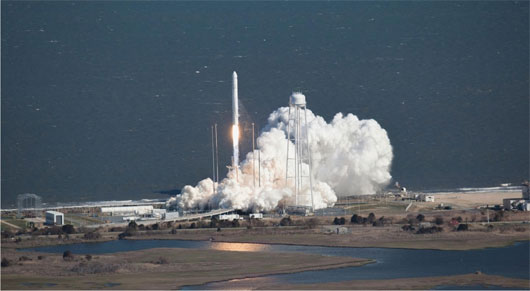Rising seawater, NASA's launch pad is repelled
Rising sea levels are threatening most of NASA's launchers and multi-billion dollar infrastructure to train future astronauts.

Bay Wallops Center did not resist the pressure of sea level rise - (Photo: NASA)
From Canaveral Cape in Florida to the flight command center in Houston, the US Space and Aeronautics Agency (NASA) is struggling to build breakwaters or even have to move some facilities deep into the mainland.
According to AFP, 5 of NASA's 7 most important centers are located along the coast, because proximity to water sources is an urgent need of any rocket launcher or pilot shipyard.
Many NASA centers have faced soaring damage due to invasive seawater, coastal landslides and storms, according to a new report.
Among the institutions threatened with launchers played a historical role in the process of human conquest of the universe, it was the Kennedy Space Center in Florida, which witnessed the missions of Apollo bringing people to the moon.
And before the sea attack, the Bay Wallops Center in Virginia, which saw 16,000 missile launches since 1945, surrendered, and the next 'victims' could be the Ames Research Center at San Francisco and Langley Research Center in Virginia, where the $ 3.5 billion flight simulation infrastructure is located.
- How to purify fresh water from seawater is simple, cheap and without electricity
- Vietnam in the group is threatened by seawater in Southeast Asia
- Iran launches the satellite as tensions are rising
- The amount of oxygen in the seawater is decreasing significantly
- Israel developed a new method to reduce seawater desalination costs
- The Israeli group considered building a seawater refinery in Vietnam
- 'Saving' innovation for 844 million people worldwide
- Seawater is rising at an unprecedented speed
- Acid in the sea is destroying coral reefs
- The two boys turned seawater into fresh water thanks to the waves
- Lack of water, science race to filter seawater into fresh water
- Pour millions of dollars into saltwater filtration technology in California
 Van Allen's belt and evidence that the Apollo 11 mission to the Moon was myth
Van Allen's belt and evidence that the Apollo 11 mission to the Moon was myth The levels of civilization in the universe (Kardashev scale)
The levels of civilization in the universe (Kardashev scale) Today Mars, the sun and the Earth are aligned
Today Mars, the sun and the Earth are aligned The Amazon owner announced a secret plan to build a space base for thousands of people
The Amazon owner announced a secret plan to build a space base for thousands of people